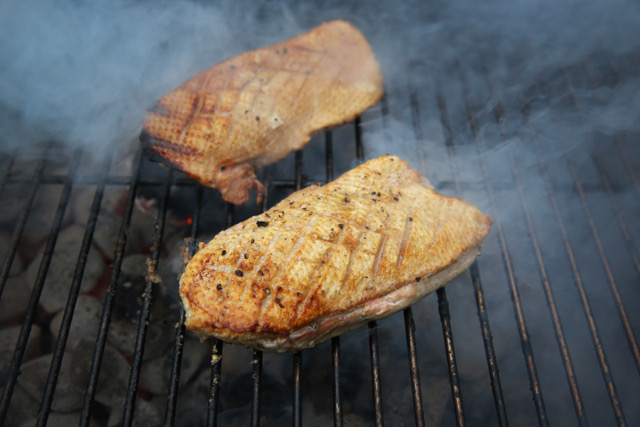Bob Hart’s recipe for Duck a l’Orange

SPICE UP THAT DUCK BREAST
Pound for pound, there are few red meats that can challenge the splendour of a premium, well-presented duck breast: treated with respect, it’s one of the world’s most luxurious and delectable offerings..
Any good, youngish duck breast will do the trick: so for this dish, pick up four matched breasts from your most reliable supplier.
Begin by trimming them carefully, if this has not already been done by your butcher. Get rid of any scraggy ends and protruding bits of fat or gristle. Be as meticulous as you like.
Coat the skin will a layer of sea salt and refrigerate overnight (if you can) for the salt to be absorbed before adding any other seasoning. And then, an hour before you intend to cook the meat, take it out of the fridge and coat it evenly with
freshly-ground black pepper.
Next, score the skin with a very sharp knife: slice diagonally (at 45 degrees) through the skin (but not the meat), and work your way most (but not quite all) of the way across the breast, in one direction, thus creating a linear pattern across
the skin which, as it crisps, will look as cool as this meat is going to taste.
Now, to get the very best out of this tantalising meat, your finest charcoal grill is required. For me, that means firing up the my beloved PK Grill, as the true aficionados among you probably guessed.
You can, of course, use any grill with which you are comfortable, and I would, as ever, be more than happy to see you using a Weber kettle or any kamado. Or even a gas grill sch as a Weber Q. Your call. But please, if you are using solid fuel, don’t
forget that chunk of pecan or hickory in the mix, OK?
The dish to which we are going to pay tribute here with our own, charcoal-inflected version is canard bigarade – the dish from which the slightly nauseating duck a l’orange emerged in the Australia of the 60s and 70s. That was a pale
successor to the original: It was sickly sweet, sticky and ordinary.
The original bigarade was none of those things, of course, as “bigarade” is the Provencal word for “Seville” – those deliciously sharp, almost spicy oranges which were used in the dish and which are most often used here for marmalade. And
those are precisely the oranges we will use, also.
The most effective way for grill enthusiasts do this is to get hold of a top-flight Seville marmalade, and there are some beauties around. Warm a generous quantity of it, and turn it into a lively glaze with a splash of water, a more serious splash of cider vinegar, and perhaps a fresh sprig or two of rosemary. Simmer this glaze for a minute or two, and you are ready for action.
Position all four breasts skin-side down on the grill at around the 200C mark, and drop the lid. Give them three or four minutes to crisp up, and to cause the sliced skin to lift and crisp. Then flip them, brush the skin side with the glaze and grill
the under side for another four minutes. Then flip, glaze the second side, and cook another two minutes, flipping and re-glazing both sides one more time, before
moving them to a gentler sector of the grill, again glazing both sides as you continue to turn them at regular intervals until they are cooked to your liking. Ideally, showing a cheeky touch of pink in mid-breast.
Finally, remove them to a cutting board where you can glaze them one last time before loosely tenting them in foil. In a perfect world, the 50ml slices into which you will divide each of these breasts when will be suitably rosy.
Serve these slices either on a sweet potato, pumpkin or parsnip puree or, as I often prefer, with a simple salad of young parsley leaves and thinly sliced red salad onions – simply dressed with lemon juice, EV olive oil, garlic, salt and pepper.
In the company of your finest pinot, of course.



